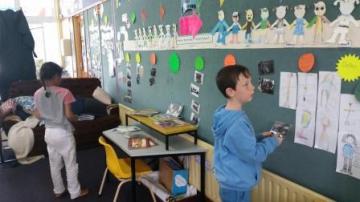Home-Happy 100th Birthday Edgecumbe Primary School
- Our team
- Learning outcomes and reflections
- Our research process
- The First Edgecumbe Primary School
- Our Edgecumbe Primary School today
- Room 7's learning journey
- The Jubilee Committee and the Big Birthday preparations
- How our school prepared for the Big Day!
- Room 1 - The Historical Room
- Friday - The day before 'Happy Birthday'
- Friday - The night before 'Happy Birthday'!
- Saturday - Happy Birthday Edgecumbe Primary School!
- EPS finally plants our trees!
- References and acknowledgements
Our research process
Our research process was simple.
When we discussed new parts of our study, we brainstormed or listed our ideas, opinions and information we knew or thought we knew and then we tried to find information from a variety of resources to prove our ideas and thoughts.
Looking for information about the Jubilee celebrations involved Room 7 to:
- Ask their parents and grandparents what it was like going to school or coming to EPS when they were students
- Ask other teachers and people from around the school about their memories of working at EPS
- Observe and discuss what was happening around the school and in other classrooms
- Visit the official Jubilee Facebook page
Looking for information about life in 1914 and other time periods involved Room 7 to:
- Ask their parents and grandparents about life when they were growing up (eg What was it like when they were little? What interests they liked to do when they were young?)
- Read through books and find information or photographs from our school library and from the National Library, NZ, that answered our questions
- Look at information and photographs from the 2013 Living Heritage story, 'Discovering Edgecumbe' created by the Year 3 - 4 / Room 7 class
- Look at YouTube music clips
- Look at old YouTube footage clips from 1914 (these were mostly about World War 1 so we only looked briefly at a few) and 1954
After we had collected our information and facts, Room 7 spent a lot of time talking about what it all meant to us and what we thought.
What were some of the activities we did?
Our inquiry plan involved:
- Thinking and discussing our ideas, opinions and information in small groups
- Researching and gathering information from library books and magazines about what it was like to live in Edgecumbe / what life was like in 2014, 1914 and 1954 from different sources of information
- Sharing our thinking with the class / reporting information back to the rest of the class
- Comparing these times and topics (eg fashion, transport)
- Matching a series of photographs (eg transport, fashion) to different times (ie 1914, 1954 and 2014) and explaining why these photographs belonged to these times - What were the clues?
- Capturing or recording these ideas by writing, drawing, taking photographs and video recordings
- Viewing YouTube clips from 1914 (e.g. music videos)
- Visiting other classrooms to see what their learning looked like
We used different ways to display our thinking and learning:
- Graphic organisers such as brainstorm bubble maps, Mindmaps, T chart, Y chart, rubric charts, P.M.I charts
- Pictorial or visual representation (ie drawing down what we think and explaining our ideas to the class)
- Letter writing
- Story writing
- Singing and dancing
- Art work (e.g. pencil sketches, crayon and dye self portraits)
- Art work - designing a t-shirt print for a tie-dyed t-shirt to celebrate our school's birthday






